
Solar power plants capture sunlight and convert it to electricity for households and businesses to use. It is an abundant, renewable, and inexpensive source of energy.
Workers in this industry perform a range of duties, such as research and development, manufacturing, construction, operation and sales. Some jobs necessitate specialized knowledge regarding solar technology while others involve selling or other business activities.
Photovoltaic (PV) cells
Photovoltaic cells utilize light from the sun and convert it to electricity. They can be constructed out of various semiconductor materials, including silicon and other thin films like cadmium telluride (CdTe).
Solar cells absorb photons, elementary particles that carry sunlight at an incredible 300,000 kilometers per second. When these photons strike semiconductor material, electrons are released from their atoms and travel toward the cell’s front surface.
Electrons are deposited onto metal plates on either side of a cell, creating an electrical circuit between n-type and p-type layers of silicon in each cell. This current then travels through wires connecting these cells together into modules or panels.
One issue with existing solar panels is that boron, an essential element in the production of silicon cells, tends to react with oxygen when exposed to sunlight and cause minor defects in the cell. Gallium, a naturally occurring metal element, could potentially help solve this issue and is already being utilized in commercial solar panel production.
Concentrating solar-thermal (CSP) systems
Concentrated solar-thermal (CSP) systems harness the sun’s energy and use it to power traditional steam turbines or engines that generate electricity. When coupled with thermal energy storage, CSP becomes an attractive solution for flexible, dispatchable power sources.
Around the world, various technologies are currently in use: parabolic trough and dish collectors; heliostat field collectors (towers); and linear Fresnel reflectors. Most current CSP projects operate at a utility scale.
CSP industry has faced obstacles due to high costs, technological limitations and environmental worries. But if these obstacles can be overcome and CSP becomes easier and cheaper to construct, then it could offer an attractive alternative to photovoltaics for large-scale power generation.
CSP technology has the potential to produce electricity as well as desalination and industrial heat applications. It could replace fossil fuels in industries requiring high temperatures, like cement or steel-making, while helping decarbonize these processes.
Semiconductor processors
A semiconductor is a small piece of silicon that contains an array of electrical switches known as transistors. These microchips form the brains behind modern computers, smartphones, cars, data center servers and game consoles alike – they’re everywhere!
Silicon’s conductive properties can be further enhanced when mixed with other elements like phosphorus or boron. When combined with its ability to be cut into wafers, this makes silicon an ideal material for crafting semiconductors.
Semiconductor processors perform their work in clean rooms that are free from particles that could harm the chips they manufacture. They don lightweight outer garments known as bunny suits to keep lint and other airborne particles out of the production area.
Semiconductor processors also perform a range of other duties, such as troubleshooting production issues, making equipment adjustments and repairs, and testing finished chips to verify they work properly. To accomplish these tasks, they may utilize electronic test equipment, precision measuring instruments, microscopes and standard procedures.
Engineers
Solar power is becoming an increasingly important source of energy, prompting more engineers to specialize in this area. They utilize their knowledge of engineering and chemistry to design solar cells that capture sun rays and convert them into useful electricity for homes and businesses.
Industrial engineers manage the production processes for all the parts and systems involved in a solar power plant. They research how to maximize production methods while eliminating waste, applying mathematical models to simulate each step along the way.
Mechanical engineers use math principles and engineering physics to design, fabricate and operate mechanical systems used in various fields such as the solar energy industry. Furthermore, they conduct research and development on new materials designed to enhance solar cell performance.
They utilize computer-aided design (CAD) software to craft designs for solar power plants and thermal energy systems, then test those designs to guarantee they meet requirements. Furthermore, they conduct financial reviews, guarantee regulatory adherence, and inspect installation sites to guarantee safety standards are upheld.